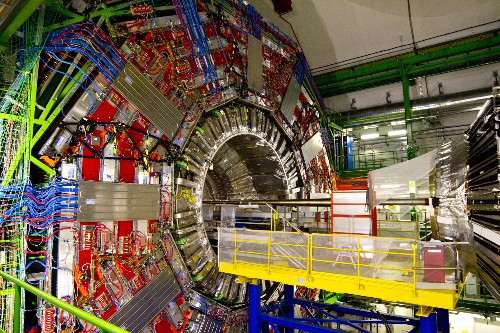
Image of the Large Hadron Collider (LHC) at Geneva, Switzerland
Researchers from the University of Bristol have been working with scientists globally to further unravel the way a unique fundamental particle, known as the Higgs boson, might interact with dark matter.
The team of physicists helped conduct the experimental analysis from the most powerful particle accelerator ever built – the Large Hadron Collider (LHC), at CERN, the European Organization for Nuclear Research, in Geneva, Switzerland.
Analysing data collected with a general-purpose detector called the Compact Muon Solenoid (CMS), at the LHC, they searched for invisible decays of the Higgs boson and achieved the most precise results to date, allowing for new insights into dark matter properties.
The results, presented at the 12th Higgs Hunting Conference in Paris last month, provide the strongest constraints on how dark matter interacts with the normal matter in our universe, assuming the dark matter mass is similar to or a few times heavier than that of a proton.
Since the discovery of the Higgs boson 10 years ago, scientists at CERN have made rapid progress in measuring and determining the properties of this unique fundamental particle by studying the different ways in which it decays. One of the most intriguing channels to search for is the "invisible" channel – a decay to particles that the experimental apparatus cannot detect. In the Standard Model of particle physics such an invisible decay is predicted to happen once in every 1000 Higgs boson decays by decaying into four neutrinos, the only "invisible" particles known in the Standard Model.
An intriguing alternative for invisible decays of the Higgs boson would be the decay to a pair of dark matter particles. The Higgs boson is responsible for the masses of all the fundamental particles of the Standard Model. It's therefore reasonable to assume it would also be responsible for the mass of so far undiscovered dark matter particles. If this was the case, the Higgs boson would interact with dark matter and as a result could decay into it, potentially significantly increasing the rate of invisible Higgs boson decays.
Higgs boson can be produced in a variety of ways at the Large Hadron Collider. The new measurement combines results from four different Higgs production modes and data taken at different centre-of-mass energies over a seven-year period, offering the most comprehensive investigation of invisible Higgs boson decays to date.
The Bristol team, comprising Professor Henning Flaecher, Dr Sudan Paramesvaran and PhD students David Anthony, Robert White and Maciej Glowacki, focussed on studying the production of Higgs bosons in association with a pair of top quarks or a W or Z boson and on carrying out the statistical combination of all channels. Collaborators included scientists from Imperial College London, Laboratoire Leprince-Ringuet at École Polytechnique in Paris and at Boston University.
Current experimental precision is still a long way from probing invisible Higgs boson decays at the level of 1 in 1000. With the new results, the researchers from CMS expected to be able to limit the probability of such decays to occur to less than eight in 100, constraining the Higgs to invisible branching fraction to below 10% for the first time. Interestingly, when analysing the data, the physicists, were only able to limit the probability of invisible Higgs decays to less than 15 in 100, or in other words, they observe a slightly larger number of events in data than expected from pure Standard Model background processes.
Bristol team lead Professor Henning Flaecher, from the School of Physics, said: "At this point the excess observed in data is not what we consider statistically significant. It is however a tantalising hint, in particular as a similar excess in data is also seen by the ATLAS experiment."
Dr Sudan Paramesvaran, who is leading Bristol's Trigger activities on CMS, the system that decides which of the 40 million proton-proton collisions per second should be kept for further analysis, added: "Analysing the data collected during the current data taking period will tell us if the small excess seen in this analysis is confirmed. In parallel we are playing a key role in preparing the experiment for the upgraded high-luminosity Large Hadron Collider, due to begin operation in 2029 and giving access to roughly ten times more data, in order to identify these collisions with much greater precision."
Prof Flaecher concluded: "While this new measurement does not give an indication of dark matter production at the LHC it can nevertheless be used to constrain its properties, namely how strongly - or weakly - dark matter interacts with the known Standard Model matter. The new results from CMS provide the strongest limits on the interaction strength for relatively light dark matter masses of a few GeV, compared to alternative approaches searching for dark matter."






